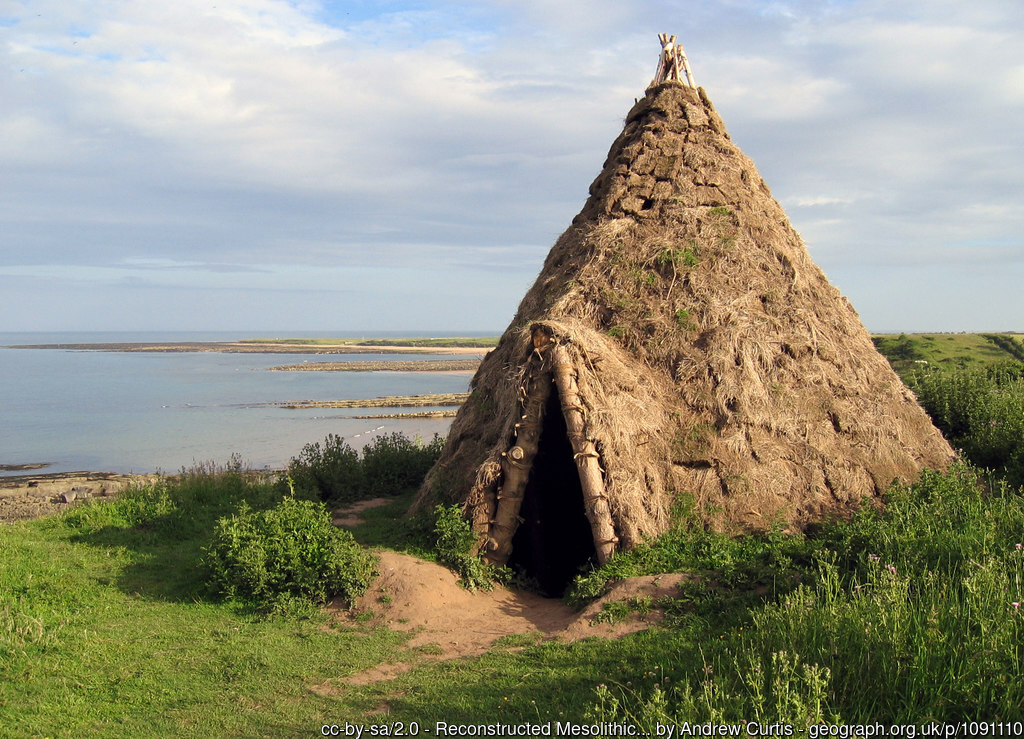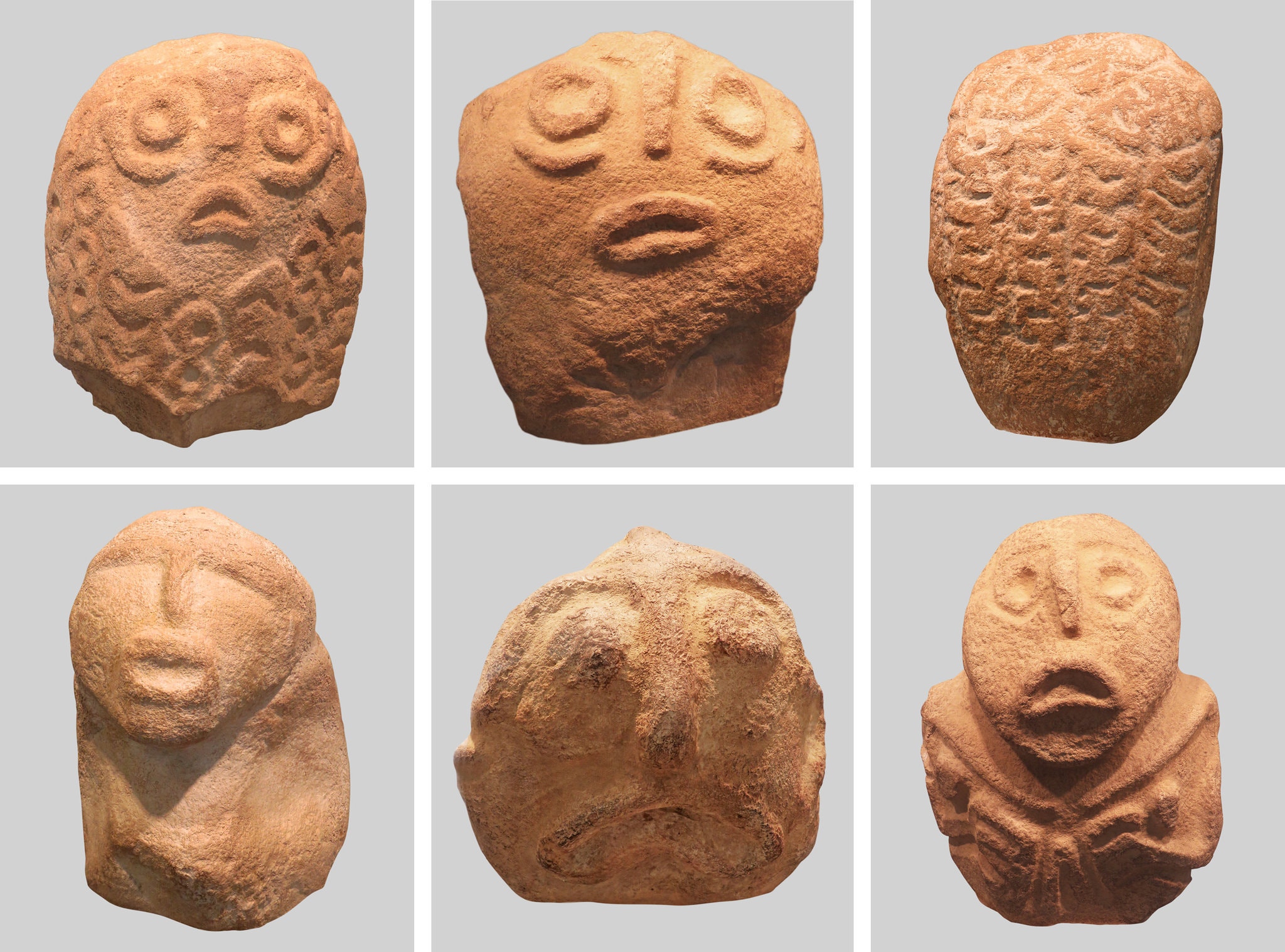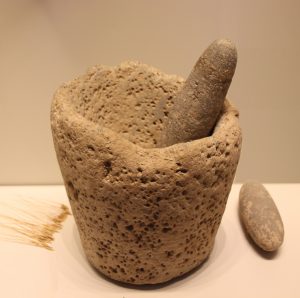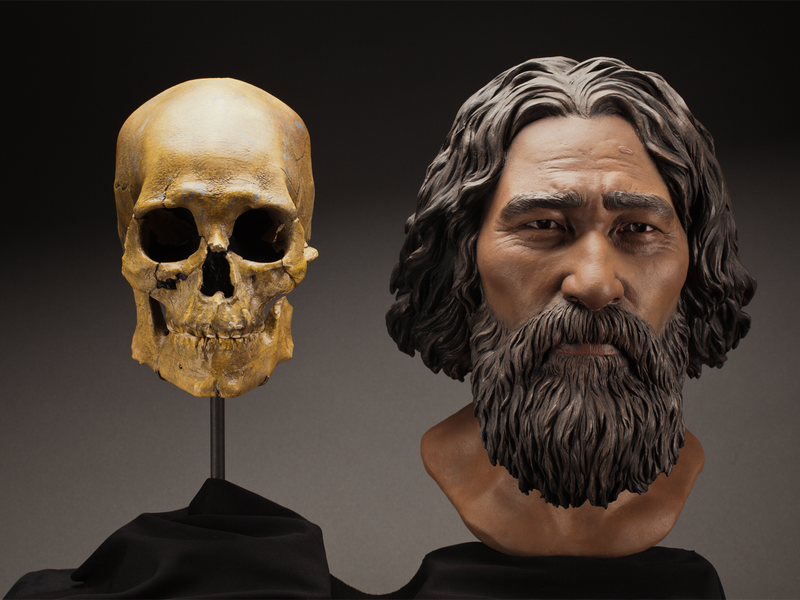
Copyright Andrew Curtis and licensed for reuse under this Creative Commons Licence
The survey crew was recording sites on the Fort Bliss military base near El Paso. We came upon a site with no pottery, but lots of debris from making stone tools along with ground stone for processing plants. I reached down and found a stone point, thick and made from a dull-gray basalt. “These Archaic Bajada points are so chunky and ugly compared to Paleo points.” He took the point in his gnarled hands (he had lost two fingers in two separate accidents). “Do you know how hard it is to make a point out of this crappy material? The person who made this knew what they were doing.” Well, that was a good point and I never forgot it. In general, people were not as mobile after the Pleistocene and did not have the same access to the best stone material. That, in turn, had consequences for their tools. Archaic folks weren’t getting dumber, they were just adapting to the dramatically new conditions of the Mesolithic/Archaic.
The end of the last Ice Age was a major turning point in the history of the human species. The Earth’s climate became warmer, and the fluctuations in the average global temperature of the Pleistocene ceased. This warm, stable period is termed the Holocene epoch, in which we live today. Many of the large animals upon which Paleolithic hunters had built their lives disappeared. As a result, human foragers broadened the range of animal and plant foods they depended on for survival, and this in turn required major shifts in technology and settlement strategies (where people live and when they occupy those areas). The dramatic leveling out of climatic conditions would eventually lead to the domestication of plants and animals and the development of social inequality, urbanism, states, and empires. The shift in climate at the end of the Pleistocene changed the world forever. In this chapter, we will explore how these momentous changes manifested themselves in cultures around the world.

The Mesolithic is not a uniform time period and goes by different names such as the Archaic period in North America and the Epipaleolithic in Southeast Asia. During this time, hunting and gathering continued, but human diets diversified to include more fish, shellfish, migratory birds, gazelles, deer, rabbits, tortoises, and many other small animals. In temperate zones, the most commonly used types of plant foods were the seeds of annual plants like wild cereals, beans, peas, lentils, squash, and tree nuts. In tropical zones, plant foods more commonly took the form of tree fruits and tubers, such as the wild forms of manioc, yams, sweet potatoes. The diversification in diet is called broad-spectrum foraging. Most noticeably, people made greater use of marine resources during the Mesolithic. The material remains from the use of marine foods are unmistakable. Huge piles of empty seashells called shell middens, along with wooden log boats 30 feet long, fishnets and traps, and bonefish hooks attest to this shift in dietary emphasis.

At the Mesolithic Ertebølle site in Jutland, in Denmark, the shell midden is 6.5 feet thick, 460 feet long, and 66 feet wide. Soils in shell middens tend to be a deep rich black to brown color from the decay of organic matter. Shellfish provided a highly reliable source of food in addition to other marine foods. At Lepenski Vir, a Mesolithic community along the Danube River in Serbia, the shift in food resources is reflected in unusual stone carvings of fish-like creatures.
In general, stone tools become smaller during this period. For example, microliths become a much more important flaked stone tool in the Mesolithic of Europe and Asia. Microliths are small pieces of sharp stone made from sections of longer blades and flakes and make more efficient use of stone. One way microliths were used was to set them into a wooden or bone/antler handle, to use as a sickle. High-quality stone became more difficult to procure due to more permanent settlements and microliths became a way to conserve stone. In other cases, as in the archaic of the American Southwest, people made do with lesser quality material.
Although the atlatl continued to be used, the bow and arrow came into common use in Europe during the Mesolithic. (Arrows were likely used much earlier in South Africa during the Pleistocene). In Europe, Mesolithic arrows with microliths affixed with resin have been recovered from bog deposits. Another important technology that becomes prevalent in the Mesolithic is ground stone. Ground stone tools were made by pecking and grinding and constituted a huge time investment. Ground stone was an essential technology for grinding seeds to make them digestible. Ground stone axes were made for cutting and clearing woods and forests. As people become increasingly sedentary, they had to intensify their efforts to get more resources out of the same area of land in order to subsist, initially by starting to consume foods that were previously lower on the preference list—foods that required additional processing in order to make them edible. A good example is acorns. Acorns are shelled and contain tannins and phytic acids, and thus require processing to make them into an edible meal. Acorns need to be cracked up to remove the nut and then ground into flour. The tannins and phytic acids are removed by leaching them in water.

Mesolithic mortar and pestle by Gary Todd is licensed under public domain.
In many Mesolithic/Archaic cultures, pottery was not used at all. There are some are examples of pottery from Pleistocene contexts, most notably from China, which represents the earliest use of pottery (Wu et al. 2012). Jomon hunter-gatherers of Japan who lived some 16,000 years had a ceramic tradition that is well documented. Among more mobile foragers, however, pottery tends to be a liability. Pottery becomes far more prevalent when people begin to practice agriculture and live in more permanent villages. Mobile foragers are thought to have used basketry to transport and store items.
What People Ate
There are numerous ways to infer what people ate in the ancient past. Plant remains, animal bones, human stomach contents, and chemical residues on artifacts can all provide clues to diet. Another way is through bone chemistry analysis. From chemistry, we know that an isotope is a variant of an element that has the same number of protons, but the number of neutrons can vary. Examples of isotopes are carbon-12, carbon-13, and carbon-14. Different plants take up different ratios of isotopes. Marine plants and animals, for example, take up relatively more carbon-13 to carbon-12 than do terrestrial resources. By looking at human bone chemistry from Mesolithic coastal settlements and comparing them to later agriculturalists, archaeologists see a dramatic shift in the isotopic signatures. Mesolithic people had high concentrations of carbon-13, revealing that they were relying more on marine resources for food than their later agriculturally-based counterparts.
It is also possible to examine reliance on plants versus animal food using bone chemistry. As one moves up the food chain, nitrogen-15 becomes more concentrated in the body. If you eat more meat, the more nitrogen-15 enriched you will be. Archaeologists can look at the ratio of nitrogen-14 and nitrogen-15 in archaeological samples to get an idea of whether the diet was plant or animal-based.
The First Domesticated Animal

Domestication refers to interfering with the reproduction of another species to produce favorable genetic changes. The earliest known domesticated animal species is the dog. While the dog becomes more common in the Mesolithic, they appear to have been domesticated in the Upper Paleolithic. In one recent discovery at Předmostí in Siberia, a dog was found with a possible mammoth bone in its mouth. A few other Upper Paleolithic sites with dogs are also known. Recent work on the dog genome suggests that dogs may have diverged from wolves in the Pleistocene perhaps 30,000-40,000 years ago. Biological Anthropologist Pat Shipman even argues in her book Invaders that dogs may have given modern humans the competitive edge to out-compete Neanderthals.
In post-Pleistocene Europe, Southeast Asia, and North America, there are dog burials in the same areas as human burials. In one famous example in the Middle East, a woman was buried with a puppy. At the 8,000-year-old Archaic Koster site in Illinois, archaeologists discovered the remains of four dog burials located in the same area as human burials.
Dogs appear to have been selected by foragers for docility or “tameness.” Some think that humans began to keep wolf pups, selecting for tamer traits which over time led to dogs. Hunter-gatherers are known to take in wild animals like monkeys, eagles, and armadillos, and care for them. The Ache of Paraguay and the Kichwa of Ecuador will sometimes adopt armadillos and monkeys, for example. Others think that dogs may have domesticated themselves in a sense. Human-tolerant dogs would be attracted to human settlements and trash dumps, and eventually, the offspring of these docile animals would be taken in by humans. One very clear advantage that dogs provide is their sense of smell, which becomes useful in hunting. We’ve got good eyesight, great dexterity, but we’re just not great smellers compared to dogs. In addition, dogs can pull loads, provide warmth, and of course, offer companionship. In a pinch, they can also be eaten.

“
Dogs, as opposed to the wolves they evolved from, are recognizable in the archaeological record by morphological changes. The snout becomes shorter, the face more indented at the rostrom, and the teeth are reduced. One way these morphological changes might have occurred is the selection for docility alone. In the famous “silver-fox experiments”, Dmitri Belyaev and Ludmilla Tutt demonstrated that breeding the most docile wild foxes resulted in very social foxes. But they also changed in form. These highly social foxes look a lot like dogs, some with patchy coats, wagging tails, shortened muzzles, and floppy ears. They even whine and bark, which wild foxes do not do. Selecting for docility alone, whether through human selection or natural selection, could have resulted in a fairly quick metamorphosis from wolf to dog.

Image by aalnik96 from Pixabay
Warfare and Violence
Humans can be remarkably cooperative, but we also have our dark side. Specialists in human bone called osteologists can examine ancient skeletal remains for signs of violent death. Evidence for lethal violence dates back more than 400,000 years in Neanderthals at Sima de Los Huesos in Spain. Skull 17 bears evidence of blunt force trauma to the front part of the skull (Sala et al. 2015). At some Mesolithic sites, there is clear evidence for violence as well. In some cases, violence is obvious. Arrowheads are found embedded in human skeletons at the Mesolithic sites of Téviec, France, and Skateholm, Sweden. At a site called Ofnet in Germany, two caches of skulls were found representing men, women, and children who all bore evidence of bludgeoning and decapitation. Recent work at Nataruk in Kenya revealed a massacre of 27 individuals, dating to around 10,000 years ago. The skeletons revealed evidence for blunt-force trauma, stone points lodged in the skull and thorax, and bound wrists. Like modern humans, clearly, early foragers were not living in a garden of Eden oblivious to violence. And yet, at many other Mesolithic sites, there is no evidence for violence.

Kennewick Man

Kennewick Man, also known as The Ancient One, is one of the earliest skeletons found in the Americas and dates to ca. 8,500 years ago, at the end of the Pleistocene and the beginning of the Holocene. Kennewick Man, like so many other remarkable finds, was found accidentally. Two college students found the skeletal remains while wading in the Columbia River in Washington on Army Corps of Engineer land (federal property) during a boat race. Thinking it was a forensic case, they called in the authorities. At first, he was thought to be an early European explorer, but radiocarbon dating quickly revealed the ancient age. Because it wasn’t clear who Kennewick Man was, a controversy ensued over who had rights to his remains. The legislation called NAGPRA or Native American Graves Protection and Repatriation Act of 1990 stipulates that Native American tribes and Hawaiian organizations have a right to claim human remains and other culturally important items found on federal lands. When human remains or objects are returned to affiliated groups, it is called repatriation. Most repatriations are non-controversial, and there is an established link between ancient remains and modern people. With Kennewick Man, the link from past to present was so distant that some scientists questioned whether a legitimate claim could be made.
The Umatilla Tribe claimed Kennewick Man as their ancestor, asserting that the tribe had been in the area since the beginning of time. The Umatilla objected to the treatment of Kennewick because ancestors are of vital importance to their culture and disrespect for remains not only violates their religious beliefs but also could have serious real-world consequences. Initially, no DNA could be gotten from Kennewick Man and he went into legal limbo and was stored at the Burke Museum. In 2015, however, scientists managed to extract his DNA and compared it to modern people. Kennewick Man turned out to be most genetically similar to indigenous Americans. Following this research, he was repatriated and reburied collectively by five different tribes in 2017.